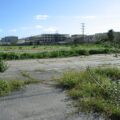The California Department of Health Services has concluded that the strontium-90 in Runkle Canyon soil and dust would create a cancer risk nearly five times this, at about 5 x 10-6.
P. 20/150: “Geocon analyzed a sample of the tarry material for total petroleum hydrocarbons (TPH) extended range by modified EPA method 8015B, volatile organic compounds (VOCs) by EPA method 8260B, and polycyclic aromatic hydrocarbons (PAHs) by EPA method 8310. The sample exhibits a total combined TPH concentration of 102,130 mg/kg. Benzene, toluene, and ethylbenzene were detected at concentrations of 35, 62, and 27 micrograms per kilogram (µg/kg). No additional VOCs were detected at or above laboratory detection limits (ND). PAHs were detected at individual concentrations up to 24.3 mg/kg.”
EnviroReporter.com was not aware of this report or these results. Neither, we suppose, was the city of Simi Valley or its residents. We note that the benzene in this tarry material found in Runkle Canyon is nearly 55 times its PRG for residential soil, the limit of which is 0.62 mg/kg and that, according to the EPA’s 2004 PRG list for contaminants, exceeds the chronic, 100% chance of contracting a cancer from this substance which is 33 k/g/mg.
P. 21/150 : Under “Conclusions and Recommendations”: “The Rocketdyne facility located to the east of the southern 715 acre parcel is reportedly the origin of groundwater plumes of degraded groundwater, containing perchlorate and TCE, that have migrated offsite to the east and southeast of the Runkle Site. Based on the reported magnitude and direction of degraded groundwater originating from the Rocketdyne facility and the results of soil, surface water, and groundwater samples collected from within Runkle Canyon it does not appear that the historic sources originating from the Rocketdyne facility are adversely affecting the Runkle property. Further evaluation of chemicals of concern potentially originating from the Rocketdyne facility appears unwarranted at this time.”
This conclusion is questionable. TCE, which has a plume of subsurface contamination in Area IV above the 11-acre drainage into Runkle Canyon, has been detected in Runkle Canyon groundwater. Perchlorate has been detected in the site’s groundwater at levels ranging up to double to 11 times what was found under adjacent Ahmanson Ranch and 55 times the Public Health Goal. The surface water has been impacted by high levels of arsenic, chromium, nickel, vanadium, barium, cadmium and lead. The surface soil has high levels of some of these heavy metals as well as strontium-90.
This Geocon report says it examined other reports to help form the conclusion that these substances aren’t coming from Rocketdyne and don’t need to be further evaluated. Apparently, Geocon did not read these reports as carefully as EnviroReporter.com has or it would have noted that in the May 8, 2003 Miller Brooks Phase I & II report performed for GreenPark Runkle, it says regarding perchlorate: “The source is thought to be the SSFL facility.”
P. 21/150: “Previous health risk assessments conducted by the property owner have concluded that the reported concentrations at the Site pose a low radiological risk to residents, visitors, and neighbors. In all cases the risk was calculated to be less than the target risk level of one in one million (1 X 10-6).”
As previously noted, the CDHS calculates the risk from strontium-90 in Runkle Canyon soil and dust to be nearly five in a million.
But if the “assessments conducted by the property owner” are to be the only source of information, that would include the Foster Wheeler reports 58 soil samples which averaged 1.39 pCi/g, or six times the EPA’s preliminary remediation goal and nearly 46 times above the typical EPA background level for Sr-90 in the area. The hottest sampling spot, and the one closest to Rocketdyne’s Santa Susana Field Laboratory, measured 12.34 pCi/g, which is over 54 times the EPA’s PRG and 411 times the normal background for the radionuclide.
P. 21/150: “Based on the odor, appearance, and the analytical laboratory results, the tar appears to be a petroleum-based substance; most likely “asphalt” or “asphalt cement”, a heavy petroleum product containing compounds with as many as 150 carbon atoms resulting from distillation of crude oil. Because the TPH extended range analysis is terminated at compounds containing approximately 40 carbon atoms, the reported analysis accounts for only 10% of the total mass of the sample.
The asphalt may have been used at the former aggregate mining operation to create asphaltic concrete for surfacing haul roads. The asphalt exposed in the stream channel is of limited lateral and vertical extent, though it may be possible that other deposits could exist elsewhere within the undocumented fill in the canyon. Geocon estimates that the volume of asphalt is approximately 12 cubic yards or less. Based on the analyses performed and the quantity of material, it is our opinion that this material does not represent an REC. In its present condition, the asphalt would not be suitable for use in fill and should be removed from the site and disposed of at a recycling facility or possibly at a Class III landfill if in solid form.”
EnviroReporter.com recommends that the petroleum-based substance, with high benzene content, be analyzed for the approximately 110 other carbon atoms, or 90% of the total mass of the sample that remains unaccounted for. We also concur with Geocon that this material be removed from the site and disposed of properly after it is correctly analyzed in DTSC’s lab and characterized in situ to determine its lateral and vertical extent.
P. 77/150: Test results of Polynuclear Aromatic Hydrocarbons include a result of 24.3 mg/kg for benzo(a)antracene which is 39.19 times its PRG of 0.62 mg/kg.
24 Years of Award-Winning SSFL/Rocketdyne Reporting
June 1998 – June 2022












Recent Comments